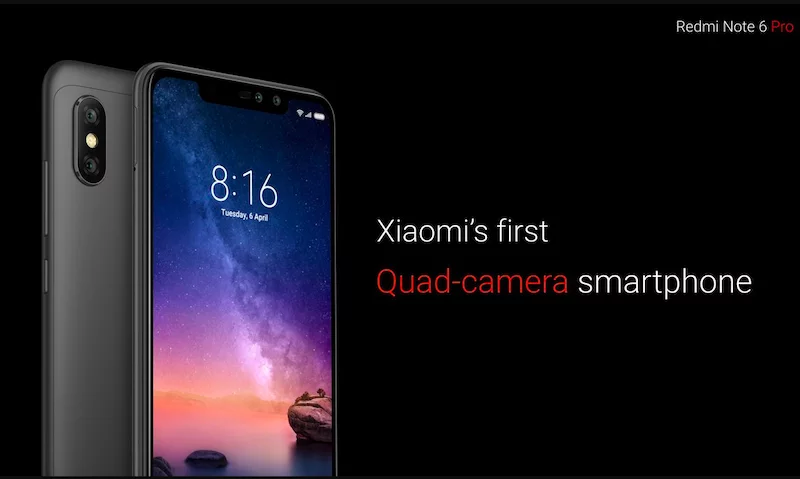After a series of teasers, Xiaomi India today brought the Redmi Note 6 Pro smartphone to the sub-continent. The Note 6 Pro succeeds the popular Redmi Note 5 Pro smartphone in the country, but sadly, it doesn't bring any major features to the table compared to its predecessor. The Redmi Note 6 Pro is Xiaomi's first phone to offer quad cameras in India- two on the front and two on the back. It's one of the rare smartphones available in the country right now to provide dual selfie cameras. Under the hood, the phone still has the good-old Snapdragon 636 chipset, clubbed with up to 6GB of RAM. While the chipset is a decent one to go with, it's disappointing to see that it has the same chipset as its predecessor. But Xiaomi has improved the camera setup as the phone now captures better low-light images than its predecessor.

Xiaomi Redmi Note 6 Pro: Specifications and Features
Starting with the display, the new smartphone from Xiaomi rocks a 6.26-inch Full HD+ screen and carries a resolution of 1080x2280 pixels. As always, Xiaomi did reveal the protective layer used on the screen is a Corning Gorilla Glass. At the heart of the phone, we have the Qualcomm Snapdragon 636 chipset, clubbed with 4GB, 6GB of RAM and 64GB of internal storage. There's a microSD card slot as well for storage expansion up to 256GB. But it's a dedicated slot as we saw on other Xiaomi smartphones launched in recent times such as the Redmi 6 Pro, Redmi 6 and Redmi 6A. Xiaomi is calling the Redmi Note 6 Pro as 'Quad camera all-rounder.'
Coming to the cameras, the Redmi Note 6 Pro has a primary 12MP sensor with f/1.9 aperture, 1/2.55-inch sensor, 1.4um and dual-pixel PDAF. A 5MP depth sensor adds the bokeh effect to images. To recall, the Redmi Note 5 Pro also had a similar camera setup but the aperture size was f/2.2. On the front side, we now get dual cameras of 20MP+2MP. The rear camera is capable of capturing videos at 1080p. Like the Note 5 Pro, the Note 6 Pro lacks 4K video recording. The rear camera comes with Electronic Image Stabilisation support. Xiaomi has also added AI Scene detection feature to the camera app.
Rest of the features are pretty much similar to the Note 5 Pro. The phone is backed by a 4000mAh battery and comes in four colour options- Blue, Black, Red and Rose Gold. Xiaomi has launched the device with MIUI 10 out of the box and it's based on Android 8.1 Oreo, not the latest Android 9 Pie. Finally, a budget Xiaomi smartphone comes with fast charging support. The Redmi Note 6 Pro has support for Qualcomm Quick Charge 3.0, but inside the retail box, we get a 10W charger. So, you've to purchase a charger separately to enjoy faster charging speeds.

As for the connectivity options, the phone offers Dual 4G, VoLTE, Wi-Fi 802.11 b/g/n/ac, Bluetooth 5.0, GPS and a Micro USB port. Yes, Xiaomi is still using a Micro USB port in 2018.
Xiaomi Redmi Note 6 Pro: Pricing and Availability in India
The Redmi Note 6 Pro in India comes in two variants- 4GB+64GB and 6GB+64GB, same as the Note 5 Pro. Xiaomi launched the device in four colours- Black, Blue, Rose Gold and Red. The base variant of the Redmi Note 6 Pro is priced at Rs 13,999, while the 6GB+64GB variant will retail for Rs 15,999. The device will be exclusive to Flipkart in the country and the first sale will take place tomorrow at 12 PM. And here's a surprise. For tomorrow during the Black Friday Sale, the Redmi Note 6 Pro will be available at Rs 12,999 for the 4GB+64GB variant and Rs 15,999 for the 6GB+64GB variant. Furthermore, HDFC Debit, Credit card users will get additional Rs 500 cashback on Flipkart, Mi.com and Mi Home stores. This discount offer is only for November 23.
Xiaomi Redmi Note 6 Pro: Competitors in India
The Redmi Note 6 Pro locks horns with the Realme 2 Pro in India. The Realme 2 Pro features a much trendy teardrop notch, slightly powerful Snapdragon 660 SoC and the pricing is also lower than the Note 6 Pro. But Xiaomi is betting big on the camera performance of the Note 6 Pro, as it did with the Note 5 Pro. On paper, the Note 6 Pro beats Realme 2 Pro in the camera specifications and we're expecting the same in the real-life scenarios.















